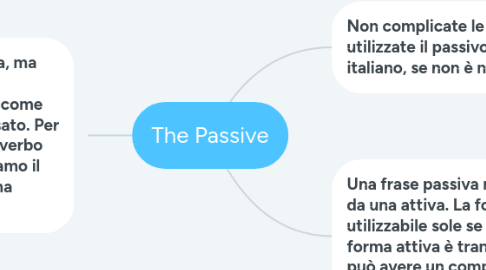The Passive
da Fabrizio Mertino


1. La formazione è elaborata, ma non è concettualmente complessa. Verbo essere come ausiliare + Participio Passato. Per determinare il tempo del verbo essere (ausiliare) osserviamo il tempo del verbo alla forma attiva.
1.1. Present Simple
1.1.1. I eat the apple -) The apple is eaten by me
1.2. Past Simple
1.2.1. He helped the man -) The man was helped by him
1.3. Present Continuous
1.3.1. She is reading the book -) The book is being read by her
1.4. Present Perfect
1.4.1. We have waited for them -) They have been waited by us
2. Non complicate le cose! Non utilizzate il passivo come in italiano, se non è necessario.
2.1. Active Form: La utilizziamo quando vogliamo indicare chi\cosa compie un'azione
2.1.1. My father built the house
2.1.2. Non complichiamoci la vita
2.1.2.1. The house was built by my father
2.2. Passive Form: La utilizziamo in contesti speciali e spesso formali
2.2.1. Quando vogliamo evidenziare più l'OGGETTO che subisce l'azione, che l'azione stessa
2.2.1.1. The palace was built in 1564
2.2.2. Quando non conosciamo, o non vogliamo specificare, il SOGGETTO
2.2.2.1. The cake has been eaten
3. Una frase passiva nasce sempre da una attiva. La forma Passiva è utilizzabile sole se il verbo della forma attiva è transitivo (cioè se può avere un complemento oggetto)
3.1. I eat the apple
3.2. Il complemento oggetto diventa quindi soggetto, mentre il vecchio soggetto diventa un complemento d'agente introdotto da "BY" (NON da "from")
3.2.1. The apple is eaten by me
